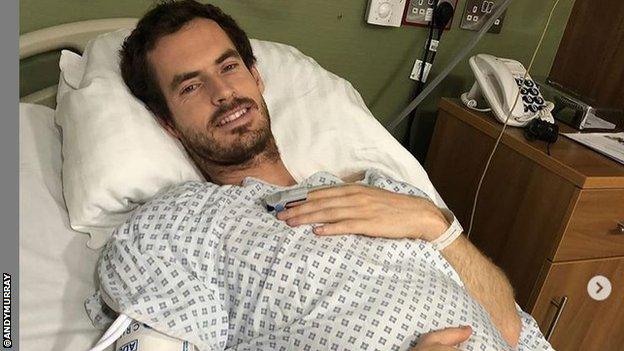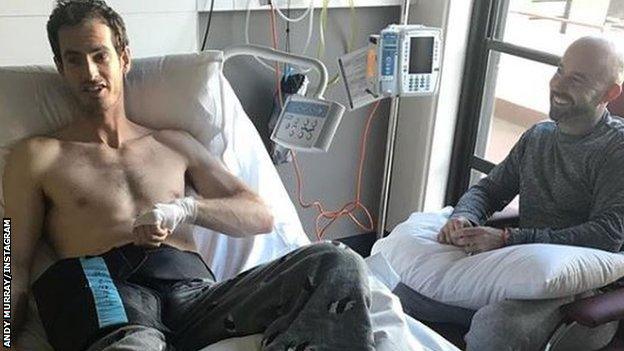Andy Murray: What did his surgery entail, and what is his long-term outlook?
- Published

Murray posted an image of himself on Instagram after his latest surgery
Is Andy Murray's tennis career over?
If the outpouring of emotion since he was knocked out of the Australian Open is anything to go by, many will hope not.
On Monday, the Briton had hip resurfacing surgery which he hopes will "be the end of my pain".
How did we get to this point?
Murray, 31, says he has had pain in his hip for "a number of years" - and after losing in the Wimbledon quarter-finals in 2017, he took the rest of the season off.
Last January he had surgery, after which he said: "I'm not finished playing tennis yet. I'm going to be competing at the highest level again."
Twelve months - and only seven tournaments - later, he gave an emotional news conference before the Australian Open, saying it could be his final tournament.
Despite a trademark fightback in his first-round match with Roberto Bautista Agut, he lost in five sets.
Speaking after the match, he said he would decide in a "week or two" what he would do next.

Murray posted this picture of himself in hospital after his hip surgery in January 2018, with coach Jamie Delgado at his bedside
What was wrong with Murray's hip and what surgery did he have?
The three-time Grand Slam champion said he had been in pain every day, even struggling to put on his socks and walk the dogs. It sounded bleak, but his team were pretty cagey about what the injury actually was.
Professor Max Fehily, consultant orthopaedic surgeon and clinical director at the Manchester Hip Clinic, believes Murray may have had hip impingement - essentially a problem with the ball-and-socket joint.
Speaking before Murray announced he had had surgery, Prof Fehily said: "Repetitive and heavy hip flexion can damage the cartilage of the socket and can lead to deformity of the ball.
"This is a common injury in high-impact sports such as martial arts, rugby and gymnastics. It's not as common in tennis, but Murray is such an impact player."
So what does a hip resurfacing operation entail?
"Smoothing down the ball, then covering it with a metal cap," explained Fehily. "Then a layer of metal is placed within the pelvic socket in which it sits."
American doubles legend Bob Bryan had a similar operation in 2018.
Bryan, 40, was on court within five months of his operation and competed with twin brother Mike at the Australian Open.
So will everything be fine now Murray has had the surgery?
Sadly, the procedure is not a magic remedy.
Even if the surgery has corrected the issue, the metal components can wear out after 10 to 15 years - earlier if the patient is very active - and revision surgery, which can be more challenging and produce poor outcomes, is often required.
Prof Fehily said: "Ninety to 95% of patients who have this surgery are delighted and live a pain-free life - they can ski, swim, cycle and play golf at the weekend.
"But none of them try to play professional tennis."
The vast majority of people who have the surgery - in the UK, at least - are over the age of 55.
What's the long-term outlook?
"If Murray is able to return to tennis, he puts himself at risk of further injury at best, and at the other end of the scale may develop severe osteoarthritis," said Prof Fehily.
But there are anomalies.
Bryan, also speaking before Murray announced he had had the operation, says the Scot has been "watching me like a hawk, asking me how I'm feeling after matches, after practices, where I'm at".
The doubles specialist, though, refers to singles as a "a different monster".
"Those guys are sliding around, killing themselves for four hours," he said. "Who knows if this joint would hold up?
"Will you have the explosiveness to be quick on the singles court? If you don't have that, you'll be exposed."
He said he would "love" Murray to have the operation "just for quality of life", adding: "You can sleep, walk, be with your kids, play."
A version of this article was first published on 17 January.